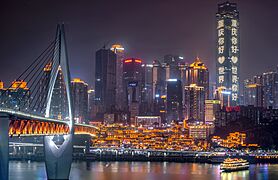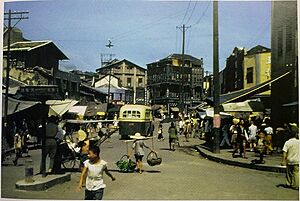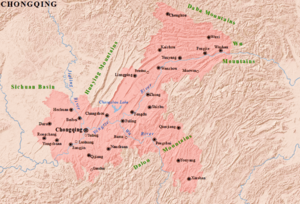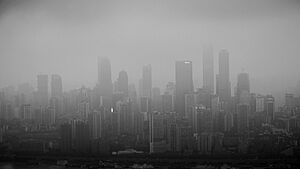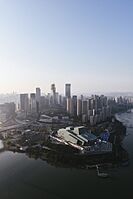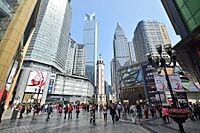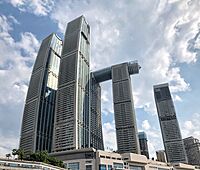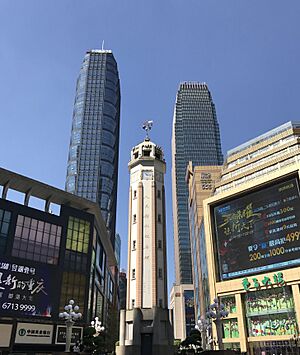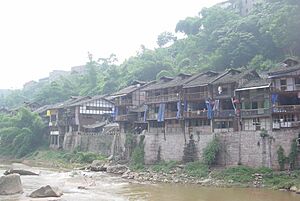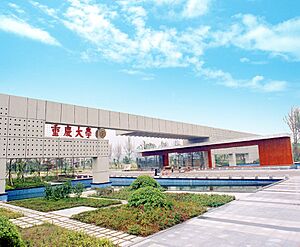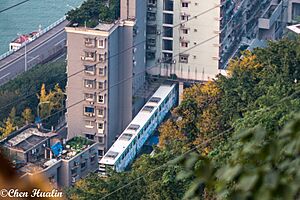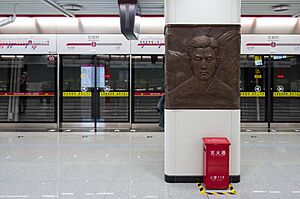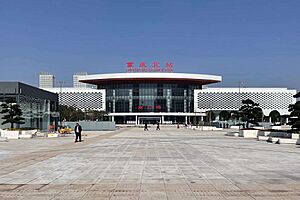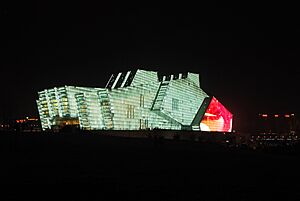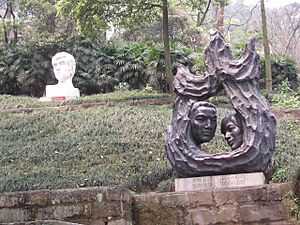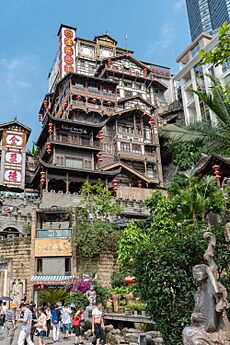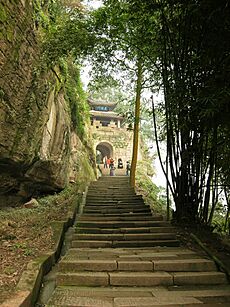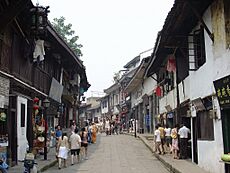Chongqing facts for kids
Quick facts for kids
Chongqing
重庆
Chungking
|
|||||||||||
|---|---|---|---|---|---|---|---|---|---|---|---|
|
Municipality
|
|||||||||||
|
Yuzhong District
Chongqing Art Museum
Liziba Station
Jiefangbei CBD
Qutang Gorge
Huguang Huiguan
Great Hall of the People
|
|||||||||||
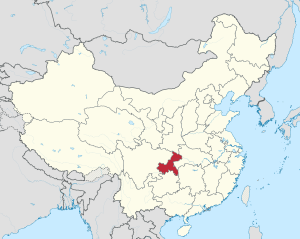
Location of Chongqing Municipality within China
|
|||||||||||
| Country | China | ||||||||||
| Settled | c. 316 BC | ||||||||||
| Separated from Sichuan | 14 March 1997 | ||||||||||
| Municipal seat | Yuzhong District | ||||||||||
| Divisions - County-level - Township-level |
26 districts, 12 counties | ||||||||||
| Government | |||||||||||
| • Type | Municipality | ||||||||||
| • Body | Chongqing Municipal People's Congress | ||||||||||
| Area | |||||||||||
| • Municipality | 82,403 km2 (31,816 sq mi) | ||||||||||
| • Built up area | 5,472.8 km2 (2,113.1 sq mi) | ||||||||||
| Elevation | 244 m (801 ft) | ||||||||||
| Highest elevation
(Yintiao Ling)
|
2,797 m (9,177 ft) | ||||||||||
| Population
(2020 census (total), 2018 (otherwise))
|
|||||||||||
| • Municipality | 32,054,159 | ||||||||||
| • Density | 388.9926/km2 (1,007.486/sq mi) | ||||||||||
| • Urban | 22,251,500 | ||||||||||
| • Built up area | 9,580,770 | ||||||||||
| • Built up area density | 1,750.616/km2 (4,534.07/sq mi) | ||||||||||
| GDP(2023) | |||||||||||
| • Municipality | CN¥ 3,015 billion (17th) US$ 428 billion |
||||||||||
| • Per capita | CN¥ 94,135 (10th) US$ 13,359 |
||||||||||
| Time zone | UTC+8 (CST) | ||||||||||
| • Summer (DST) | UTC+9 (CDT) | ||||||||||
| Postal codes |
4000 00 – 4099 00
|
||||||||||
| Area code(s) | 23 | ||||||||||
| ISO 3166 code | CN-CQ | ||||||||||
| – Growth | |||||||||||
| Abbreviation | CQ / 渝; Yú | ||||||||||
| Climate | Cfa | ||||||||||
| HDI (2022) | 0.795 (9th) – high | ||||||||||
|
|||||||||||
| Chongqing | |||||||||||||||||||||||||||||||||||||||||||
|---|---|---|---|---|---|---|---|---|---|---|---|---|---|---|---|---|---|---|---|---|---|---|---|---|---|---|---|---|---|---|---|---|---|---|---|---|---|---|---|---|---|---|---|

"Chongqing" in Simplified (top) and Traditional (bottom) Chinese characters
|
|||||||||||||||||||||||||||||||||||||||||||
| Simplified Chinese | 重庆 | ||||||||||||||||||||||||||||||||||||||||||
| Traditional Chinese | 重慶 | ||||||||||||||||||||||||||||||||||||||||||
| Postal | Chungking | ||||||||||||||||||||||||||||||||||||||||||
| Literal meaning | "Doubled Celebration" | ||||||||||||||||||||||||||||||||||||||||||
|
|||||||||||||||||||||||||||||||||||||||||||
Chongqing is a huge city in Southwestern China. It's one of China's four special cities that are managed directly by the central government, like Beijing and Shanghai. What makes Chongqing unique is that it's the only one located far inland. The area it covers is massive, about the size of Austria! It includes not just the main city but also many smaller towns and rural areas. This makes Chongqing the largest city in the world by total area.
Chongqing is also China's only municipality with over 30 million people. This number includes everyone living in its vast rural areas. By 2022, its urban population was over 22 million, making it China's largest city by urban population. The city has 26 districts and many counties. During the Second Sino-Japanese War (1937–1945), Chongqing was the capital of China. In 1997, it became a special municipality, separate from Sichuan province, to help develop western China.
Chongqing is a very important city for finance, manufacturing, and transportation in its region. It's a key part of China's major economic plans. Chongqing Jiangbei International Airport is one of the busiest airports in China. The city also has the world's longest and busiest monorail system, with many stations. Chongqing is considered a "Beta" global city, meaning it's a major world city. It's home to Changan Automobile, one of China's biggest car makers. The city also has many great universities, like Chongqing University.
Contents
- Discovering Chongqing's Past
- Exploring Chongqing's Landscape
- City Views and Landmarks
- People and Culture
- Chongqing's Economy and Industries
- Education and Learning
- Getting Around Chongqing
- Fun Things to Do in Chongqing
- Sports and Fun
- Famous People from Chongqing
- Chongqing's Global Connections
- Images for kids
- See also
Discovering Chongqing's Past
Ancient Times: The Ba State
Chongqing's story began a very long time ago with the State of Ba. Its first capital was called Jiangzhou.
Imperial Eras: From Jiangzhou to Chongqing
After the Ba State, Jiangzhou was part of the Qin dynasty and later the Han dynasty. Over time, its name changed several times. In 581 AD, it was called Yu Prefecture. This name, "Yu," is still used today as a short way to refer to Chongqing. The city's main area is even called Yuzhong, meaning "Central Yu."
The name "Chongqing" came about in 1189. A prince named Zhao Dun became king and then emperor. He called this a "double celebration," which in Chinese is chóngqìng. So, Yu Prefecture was renamed Chongqing to mark this special event.
Later, during the Yuan dynasty and Ming dynasty, there were short-lived kingdoms with Chongqing as their capital. In 1644, after the Ming dynasty fell, a rebel leader named Zhang Xianzhong took over Chongqing. Many people moved away from the area during this time. Later, the Manchus conquered the province, and new people moved to Chongqing and Sichuan with the support of the Qing emperor.
In the late 1800s, Chongqing became an important port for foreign trade. Consulates from countries like Britain, America, Germany, France, and Japan opened here.
Wartime Capital: A City of Heroes
From 1937 to 1946, Chongqing became the temporary capital of China during the Second Sino-Japanese War. This was a very difficult time. The city faced many bombing attacks from the Imperial Japanese forces. However, the people of Chongqing showed incredible strength and courage. They built air-raid shelters in the mountains, which saved many lives.
Because of its strong spirit and sacrifices during the war, Chongqing was known as the "City of Heroes." Many factories and universities moved to Chongqing from eastern China during the war, which helped the city grow into an industrial center.
Becoming a Modern Municipality
On March 14, 1997, a big change happened. Chongqing, along with some nearby areas, became its own special municipality. This was done to help develop the western parts of China and to help people move from areas affected by the Three Gorges Dam project.
In 2010, Chongqing was named one of China's four "National Central Cities." This means it's a very important city for the country's development, especially in western China.
Exploring Chongqing's Landscape
Mountains, Rivers, and Unique Landforms
Chongqing is in a special part of China, between the Tibetan Plateau and the Yangtze River plains. It has a monsoon climate, meaning it often rains, especially at night in spring and early summer. The city is famous for its "night rain in the Ba Mountains," which has been written about in many Chinese poems.
The area is full of rivers and mountains. The Daba Mountains are in the north, and the Wuling Mountains are in the southeast. The land slopes down towards the Yangtze River valley. You can find amazing Karst landscapes here, with stone forests, tall peaks, and limestone caves. The Longshuixia Gap, with its Three Natural Bridges, is a popular spot for tourists.
The mighty Yangtze River flows through Chongqing for a long distance. It cuts through the Wu Mountains, forming the famous Three Gorges: Qutang, Wuxia, and Xiling. The Jialing River also joins the Yangtze in Chongqing.
The main part of Chongqing city is built right on the mountains, surrounded by the Yangtze and Jialing rivers. This gives it a very special look, with mountains, rivers, forests, and caves all around.
Chongqing's Climate: The Fog City
Chongqing has a humid subtropical climate. It's known as one of the "Three Furnaces" of the Yangtze River because its summers are very long, hot, and humid. Winters are short and mild, but often cloudy and damp.
The city is also famous for its fog, earning it the nickname "Fog City." It has over 100 foggy days each year, especially in spring and fall. This fog might have even helped protect the city during the Second Sino-Japanese War by making it harder for planes to see.
| Climate data for Chongqing (Shapingba District), elevation 259 m (850 ft), (1991–2020 normals, extremes 1951–present) | |||||||||||||
|---|---|---|---|---|---|---|---|---|---|---|---|---|---|
| Month | Jan | Feb | Mar | Apr | May | Jun | Jul | Aug | Sep | Oct | Nov | Dec | Year |
| Record high °C (°F) | 18.8 (65.8) |
27.6 (81.7) |
34.0 (93.2) |
36.5 (97.7) |
38.9 (102.0) |
39.8 (103.6) |
42.0 (107.6) |
43.7 (110.7) |
42.0 (107.6) |
37.4 (99.3) |
29.6 (85.3) |
21.5 (70.7) |
43.7 (110.7) |
| Mean daily maximum °C (°F) | 10.4 (50.7) |
13.6 (56.5) |
18.6 (65.5) |
23.9 (75.0) |
27.4 (81.3) |
29.8 (85.6) |
33.7 (92.7) |
33.9 (93.0) |
28.5 (83.3) |
22.0 (71.6) |
17.3 (63.1) |
11.7 (53.1) |
22.6 (72.6) |
| Daily mean °C (°F) | 8.1 (46.6) |
10.4 (50.7) |
14.5 (58.1) |
19.2 (66.6) |
22.6 (72.7) |
25.4 (77.7) |
28.9 (84.0) |
28.9 (84.0) |
24.4 (75.9) |
18.9 (66.0) |
14.5 (58.1) |
9.5 (49.1) |
18.8 (65.8) |
| Mean daily minimum °C (°F) | 6.4 (43.5) |
8.3 (46.9) |
11.7 (53.1) |
16.0 (60.8) |
19.4 (66.9) |
22.4 (72.3) |
25.4 (77.7) |
25.3 (77.5) |
21.5 (70.7) |
16.8 (62.2) |
12.5 (54.5) |
8.0 (46.4) |
16.1 (61.0) |
| Record low °C (°F) | −1.8 (28.8) |
−0.8 (30.6) |
1.2 (34.2) |
2.8 (37.0) |
10.8 (51.4) |
15.5 (59.9) |
19.2 (66.6) |
17.8 (64.0) |
14.3 (57.7) |
6.9 (44.4) |
0.7 (33.3) |
−1.7 (28.9) |
−1.8 (28.8) |
| Average precipitation mm (inches) | 20.7 (0.81) |
22.4 (0.88) |
55.6 (2.19) |
103.4 (4.07) |
142.5 (5.61) |
212.1 (8.35) |
174.2 (6.86) |
125.7 (4.95) |
124.7 (4.91) |
95.3 (3.75) |
50.4 (1.98) |
24.7 (0.97) |
1,151.7 (45.33) |
| Average precipitation days (≥ 0.1 mm) | 10.0 | 8.9 | 11.5 | 13.6 | 16.0 | 16.0 | 11.3 | 11.5 | 12.6 | 15.8 | 11.3 | 10.6 | 149.1 |
| Average snowy days | 0.2 | 0.1 | 0 | 0 | 0 | 0 | 0 | 0 | 0 | 0 | 0 | 0.1 | 0.4 |
| Average relative humidity (%) | 82 | 78 | 75 | 75 | 76 | 79 | 73 | 70 | 77 | 84 | 83 | 84 | 78 |
| Mean monthly sunshine hours | 16.6 | 32.9 | 72.8 | 105.8 | 109.7 | 98.7 | 169.3 | 175.2 | 102.6 | 46.6 | 35.0 | 18.0 | 983.2 |
| Percent possible sunshine | 5 | 10 | 19 | 27 | 26 | 24 | 40 | 43 | 28 | 13 | 11 | 6 | 21 |
| Average ultraviolet index | 4 | 6 | 8 | 10 | 11 | 12 | 12 | 11 | 10 | 7 | 5 | 4 | 8 |
| Source 1: China Meteorological Administration | |||||||||||||
| Source 2: Weather Atlas (uv) | |||||||||||||
| Climate data for Chongqing (Yubei District), elevation 465 m (1,526 ft), (1991–2020 normals, extremes 1981–2010) | |||||||||||||
|---|---|---|---|---|---|---|---|---|---|---|---|---|---|
| Month | Jan | Feb | Mar | Apr | May | Jun | Jul | Aug | Sep | Oct | Nov | Dec | Year |
| Record high °C (°F) | 16.8 (62.2) |
23.7 (74.7) |
32.3 (90.1) |
34.1 (93.4) |
36.1 (97.0) |
35.6 (96.1) |
38.7 (101.7) |
41.7 (107.1) |
40.9 (105.6) |
33.1 (91.6) |
27.7 (81.9) |
17.9 (64.2) |
41.7 (107.1) |
| Mean daily maximum °C (°F) | 8.9 (48.0) |
12.0 (53.6) |
16.9 (62.4) |
22.2 (72.0) |
25.6 (78.1) |
28.0 (82.4) |
32.0 (89.6) |
32.3 (90.1) |
27.0 (80.6) |
20.6 (69.1) |
16.0 (60.8) |
10.2 (50.4) |
21.0 (69.8) |
| Daily mean °C (°F) | 6.7 (44.1) |
9.0 (48.2) |
13.2 (55.8) |
18.0 (64.4) |
21.4 (70.5) |
24.1 (75.4) |
27.6 (81.7) |
27.6 (81.7) |
23.1 (73.6) |
17.7 (63.9) |
13.2 (55.8) |
8.0 (46.4) |
17.5 (63.5) |
| Mean daily minimum °C (°F) | 5.1 (41.2) |
7.1 (44.8) |
10.6 (51.1) |
15.0 (59.0) |
18.4 (65.1) |
21.3 (70.3) |
24.2 (75.6) |
24.1 (75.4) |
20.4 (68.7) |
15.7 (60.3) |
11.4 (52.5) |
6.5 (43.7) |
15.0 (59.0) |
| Record low °C (°F) | −7.4 (18.7) |
0.2 (32.4) |
0.0 (32.0) |
4.9 (40.8) |
9.6 (49.3) |
14.0 (57.2) |
18.2 (64.8) |
17.4 (63.3) |
13.2 (55.8) |
6.2 (43.2) |
2.6 (36.7) |
−2.8 (27.0) |
−7.4 (18.7) |
| Average precipitation mm (inches) | 19.6 (0.77) |
22.6 (0.89) |
55.2 (2.17) |
101.2 (3.98) |
154.8 (6.09) |
205.6 (8.09) |
167.4 (6.59) |
130.9 (5.15) |
129.3 (5.09) |
104.8 (4.13) |
52.4 (2.06) |
24.4 (0.96) |
1,168.2 (45.97) |
| Average precipitation days (≥ 0.1 mm) | 9.9 | 9.4 | 12.0 | 14.1 | 16.5 | 16.2 | 12.3 | 10.9 | 13.0 | 16.7 | 11.9 | 11.2 | 154.1 |
| Average snowy days | 1.0 | 0.4 | 0 | 0 | 0 | 0 | 0 | 0 | 0 | 0 | 0 | 0.2 | 1.6 |
| Average relative humidity (%) | 83 | 79 | 75 | 76 | 82 | 75 | 72 | 79 | 85 | 84 | 85 | 79 | 80 |
| Mean monthly sunshine hours | 35.9 | 45.5 | 85.8 | 116.9 | 126 | 112 | 195.8 | 208.4 | 127.7 | 70.4 | 59.4 | 34.9 | 1,218.7 |
| Percent possible sunshine | 11 | 14 | 23 | 30 | 30 | 27 | 46 | 51 | 35 | 20 | 19 | 11 | 26 |
| Source: China Meteorological Administration | |||||||||||||
| Climate data for NE Chongqing (Wushan County), elevation 276 m (906 ft), (1991–2014 normals, extremes 1981–2010) | |||||||||||||
|---|---|---|---|---|---|---|---|---|---|---|---|---|---|
| Month | Jan | Feb | Mar | Apr | May | Jun | Jul | Aug | Sep | Oct | Nov | Dec | Year |
| Record high °C (°F) | 21.8 (71.2) |
27.5 (81.5) |
34.3 (93.7) |
37.5 (99.5) |
40.8 (105.4) |
41.9 (107.4) |
42.1 (107.8) |
42.8 (109.0) |
42.2 (108.0) |
35.5 (95.9) |
26.4 (79.5) |
20.7 (69.3) |
42.8 (109.0) |
| Mean daily maximum °C (°F) | 10.9 (51.6) |
13.6 (56.5) |
18.6 (65.5) |
24.3 (75.7) |
27.9 (82.2) |
31.3 (88.3) |
34.1 (93.4) |
34.3 (93.7) |
29.7 (85.5) |
23.6 (74.5) |
18.3 (64.9) |
12.4 (54.3) |
23.2 (73.8) |
| Daily mean °C (°F) | 7.5 (45.5) |
9.7 (49.5) |
13.6 (56.5) |
18.8 (65.8) |
22.5 (72.5) |
26 (79) |
28.6 (83.5) |
28.5 (83.3) |
24.6 (76.3) |
19.1 (66.4) |
14.3 (57.7) |
9.2 (48.6) |
18.5 (65.4) |
| Mean daily minimum °C (°F) | 5.0 (41.0) |
7.0 (44.6) |
10.0 (50.0) |
14.8 (58.6) |
18.7 (65.7) |
22.2 (72.0) |
24.7 (76.5) |
24.5 (76.1) |
21.1 (70.0) |
16.1 (61.0) |
11.5 (52.7) |
6.9 (44.4) |
15.2 (59.4) |
| Record low °C (°F) | −2.1 (28.2) |
−0.2 (31.6) |
1.6 (34.9) |
3.4 (38.1) |
11.4 (52.5) |
15.5 (59.9) |
18.6 (65.5) |
17.2 (63.0) |
13.1 (55.6) |
5.8 (42.4) |
3.1 (37.6) |
−3.4 (25.9) |
−3.4 (25.9) |
| Average precipitation mm (inches) | 10.9 (0.43) |
24.9 (0.98) |
42.6 (1.68) |
87.5 (3.44) |
142.2 (5.60) |
143.4 (5.65) |
166.7 (6.56) |
132.4 (5.21) |
108 (4.3) |
86.2 (3.39) |
46.9 (1.85) |
14.9 (0.59) |
1,006.6 (39.68) |
| Average precipitation days (≥ 0.1 mm) | 5.4 | 6.4 | 10.3 | 13.4 | 14.4 | 12.9 | 13.0 | 11.0 | 10.7 | 12.3 | 9.1 | 6.9 | 125.8 |
| Average snowy days | 1.5 | 0.5 | 0.2 | 0 | 0 | 0 | 0 | 0 | 0 | 0 | 0 | 0.3 | 2.5 |
| Average relative humidity (%) | 65 | 63 | 63 | 66 | 70 | 71 | 71 | 67 | 68 | 72 | 71 | 69 | 68 |
| Mean monthly sunshine hours | 74.1 | 71.9 | 111.9 | 133.7 | 144.4 | 156.7 | 194.1 | 202.6 | 147.8 | 117.1 | 101.7 | 76.5 | 1,532.5 |
| Percent possible sunshine | 23 | 23 | 30 | 34 | 34 | 37 | 45 | 50 | 40 | 34 | 32 | 24 | 34 |
| Source: China Meteorological Administration | |||||||||||||
City Views and Landmarks
-
Jiefangbei (Chinese: 解放碑; literally "People's Liberation Monument") is a World War II victory monument.
People and Culture
Population: A Giant City
| Historical population | ||
|---|---|---|
| Year | Pop. | ±% |
| 1949 | 1,003,000 | — |
| 1979 | 6,301,000 | +528.2% |
| 1983 | 13,890,000 | +120.4% |
| 1996 | 15,297,000 | +10.1% |
| 1997* | 28,753,000 | +88.0% |
| 2000 | 28,488,200 | −0.9% |
| 2005 | 27,980,000 | −1.8% |
| 2008 | 28,390,000 | +1.5% |
| 2012 | 28,846,170 | +1.6% |
| 2013 | 29,700,000 | +3.0% |
| 2014 | 29,914,000 | +0.7% |
| 2015 | 30,170,000 | +0.9% |
| *Population size in 1997 was affected by expansion of administrative divisions. | ||
Chongqing is home to over 32 million people, making it one of the most populated cities in the world. In 2010, the central urban area alone had about 17 million residents. Most of Chongqing's population, about 70%, lives in urban areas.
Languages Spoken
Most people in Chongqing speak a type of Southwestern Mandarin called Sichuanese Mandarin. This includes the main Chengdu-Chongqing dialect. Because of past migrations, some people also speak Xiang Chinese and Hakka Chinese. In some parts of southeastern Chongqing, you might also hear Miao and Tujia languages spoken by the Miao and Tujia people.
Delicious Chongqing Food
Chongqing is famous for its spicy food, which is part of Sichuan cuisine. The food often has a numbing feeling because of the Sichuan pepper. You can find many restaurants and food stalls in the city center. Many dishes are served in small portions, perfect for one person.
Here are some local favorites:
- Chongqing hot pot – This is a must-try! You cook your own food, like beef, pork, or vegetables, in a spicy broth at your table.
- Chongqing Xiao Mian – These are spicy noodles mixed with chili oil and many other tasty ingredients.
- Jiangtuan fish – Since Chongqing is by the Jialing River, fresh fish is popular. Jiangtuan fish, a type of bighead carp, is often steamed or baked.
- Suan La Fen (Sour and Spicy Sweet-Potato Noodles) – These are thick, chewy noodles in a hot and sour soup.
- Laziji (Spicy Chicken) – This dish has crispy, deep-fried chicken pieces with lots of dried chili peppers and Sichuan peppercorns.
- Fish with pickled mustard greens – Another popular Chongqing dish with a unique flavor.
Chongqing's Economy and Industries
Chongqing is a major economic hub in western China. The government has worked hard to make it a center for business, trade, and finance. The city is growing very fast, with new buildings going up every day for homes, shops, and factories.
Chongqing is a huge manufacturing center. It's one of China's biggest places for making cars and the largest for motorcycles. Big companies like Changan Automotive Corp and Ford Motor Company have factories here. The city also produces iron, steel, and aluminum.
Even though Chongqing is very industrial, farming is still important. Rice and fruits, especially oranges, are grown here. The area also has many natural resources like coal, natural gas, and minerals.
Chongqing has invested a lot in its infrastructure to attract businesses. New roads and railways connect it to the rest of China, making it easier to transport goods. The Three Gorges Dam, the world's largest dam, provides power and allows large ships to reach Chongqing's port on the Yangtze River. These improvements have brought many international companies to the city.
Education and Learning
As of 2022[update], Chongqing has 70 universities and colleges. This makes it one of the top cities in China for higher education, and the leading city in western China. Chongqing is also a global leader in scientific research.
Universities and Colleges
- Chongqing University
- Southwest University
- Chongqing University of Science and Technology
- Southwest University of Political Science and Law
- Army Medical University
- Chongqing University of Posts and Telecommunications
- Chongqing University of Technology
- Chongqing Jiaotong University
- Chongqing Medical University
- Chongqing Normal University
- Chongqing Technology and Business University
- Chongqing Three Gorges University
- Sichuan Fine Arts Institute
- Sichuan International Studies University
- Yangtze Normal University
Notable High Schools
- Chongqing Nankai Secondary School
- Bashu Secondary School
- Chongqing Foreign Language School
Getting Around Chongqing
Since 1997, Chongqing has greatly improved its transportation. It's now a major hub for travel in southwestern China, with new railways and expressways.
The city has many bridges crossing the Yangtze and Jialing rivers. There are over 30 bridges across the Yangtze River alone in the urban area! Chongqing is sometimes called the 'Bridge Capital of China' because of all its unique bridges.
Public Transport: Metro, Monorail, and Buses
Chongqing has a great public transport system. It includes a metro, intercity trains, a large bus network, and the world's biggest monorail system.
The city is building even more metro and monorail lines. By 2020, there were 6 lines and 1 loop line, covering a long distance with many stations. More lines are planned for the future!
Unique Aerial Tramway
Chongqing is the only city in China that still uses public aerial tramways. The Yangtze River Tramway is still running and is a popular tourist attraction. It connects the two sides of the Yangtze River and carries about 10,000 people every day.
Trains: Connecting Chongqing
Chongqing has several major train stations:
- Chongqing railway station: The oldest station, located near the city center.
- Chongqing North railway station: A newer station for long-distance and high-speed trains.
- Chongqing West railway station: Another large station for long-distance and high-speed services.
- Shapingba railway station: Handles local and regional trains.
Chongqing is an important train hub, connecting to many other cities across China.
River Port: Waterways of Trade

Chongqing is one of China's most important inland ports. Many luxury cruise ships start their journeys here, sailing down the Yangtze River. The construction of the Three Gorges Dam has made it easier for larger cargo ships to reach Chongqing, helping with the transport of goods like coal and minerals.
Highways: Roads Through Mountains
Building roads in Chongqing is challenging because of the mountains and rivers. The city has built many tunnels and large bridges to create a good road network. Several expressways now connect Chongqing to nearby provinces.
You won't see many motorbikes or bicycles on Chongqing's roads because of the very hilly terrain. Even so, Chongqing is a big center for making these types of vehicles!
Airports: Flying High
The main airport for Chongqing is Chongqing Jiangbei International Airport. It's a very important airport for southwest China, with flights to many cities in China and around the world. It's a hub for several airlines and is one of the busiest airports in mainland China.
The airport has three terminals and two runways. You can reach it by metro using CRT Line 3 and Line 10.
There are also four other airports in Chongqing Municipality that handle domestic flights.
Fun Things to Do in Chongqing
Chongqing has many interesting places to visit, especially because of its history as China's wartime capital.
- People's Liberation Monument: This monument is in the city center and used to be the tallest building. It was built to celebrate victory over the Axis powers in World War II.
- General Joseph W. Stilwell Museum: This museum honors General "Vinegar Joe" Stilwell, an American general from World War II.
- The Great Hall of the People: A huge public building that looks like traditional Chinese architecture.
- Three Gorges Museum: Learn about the history, culture, and environment of the Three Gorges area.
- Chongqing Art Museum: Known for its cool building design.
- Huangguan Escalator: The second longest escalator in Asia!
- The Dazu Rock Carvings: These are ancient religious sculptures carved into rocks, some dating back to the 7th century. They are a UNESCO World Heritage Site.
- The Three Natural Bridges and Furong Cave: These amazing natural formations are part of a UNESCO World Heritage Site in Wulong County.
- Ciqikou: A 1000-year-old town with a rich history as a busy trading port.
- Fishing Town: An ancient battlefield famous for its strong resistance against Mongol armies.
- Fengdu Ghost City: A place linked to traditional Chinese stories about the afterlife.
- Chongqing Zoo: See rare animals like the giant panda.
- Chongqing Grand Theater: A modern place for performances.
- Hongya Cave: A popular tourist spot with traditional stilted houses built into the cliffside.
Sports and Fun
Basketball
Chongqing used to have a professional basketball team called the Chongqing Soaring Dragons, which played in the Chinese Basketball Association. They later moved to Beijing.
Soccer
Chongqing has had professional soccer teams in the past, including Chongqing Liangjiang Athletic. They played in the top Chinese league and even won the Chinese FA Cup in 2000.
Sports Venues
- Chongqing Olympic Sports Center: A large stadium mostly used for soccer games, holding over 58,000 people.
- Yanghe Stadium: Another stadium used for soccer, with a capacity of 32,000.
Cloud Valley: A Smart City Project
Chongqing is also home to an exciting new project called Cloud Valley. It's an AI-controlled campus that uses sensors and smart devices to collect data about the city and its residents. The goal is for the AI to use this information to make life better for everyone living there.
Famous People from Chongqing
Many notable people come from Chongqing, including:
- Ba Manzi: A legendary hero from ancient times.
- Qin Liangyu: A famous heroine from the Ming dynasty.
- Nie Rongzhen: A marshal of the Chinese army.
- Liu Bocheng: An early leader of the Chinese Communist Party.
- Li Yundi: A world-famous pianist.
- Karry Wang and Roy Wang: Members of the popular pop band TFBoys.
- Xiao Zhan: A famous actor and singer.
- Shi Tingmao: An Olympic gold medalist in diving.
- Domee Shi: A Chinese-Canadian animator and director who won an Oscar.
Chongqing's Global Connections
Consulates in Chongqing
Chongqing hosts consulates from several countries, showing its importance on the world stage. These include:
- Canada
- United Kingdom
- Japan
- Italy
- Uruguay
- And more!
Sister Cities Around the World
Chongqing has "sister city" relationships with many cities across the globe. This means they share cultural and economic ties. Some of its sister cities include:
 Toulouse, France
Toulouse, France Seattle, United States
Seattle, United States Detroit, United States
Detroit, United States Toronto, Canada
Toronto, Canada Hiroshima, Japan
Hiroshima, Japan Leicester, United Kingdom
Leicester, United Kingdom Düsseldorf, Germany
Düsseldorf, Germany Brisbane, Australia
Brisbane, Australia Busan, South Korea
Busan, South Korea Bangkok, Thailand
Bangkok, Thailand Chennai, India
Chennai, India Telde, Spain
Telde, Spain
Images for kids
-
The Jade Emperor at the Fengdu Ghost City.
See also
 In Spanish: Chongqing para niños
In Spanish: Chongqing para niños


